|
|
June 15th, 2009
Study Finds Spice-Rich Marinades Can Reduce Harmful Compounds When Grilling
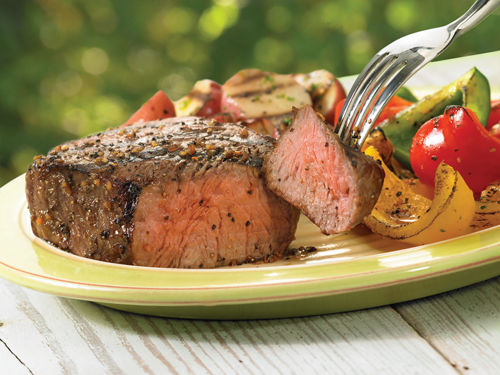 Grilled Montreal Steak Seasoned Steak McCormick Has Flavorful Marinades Offer Easy Ways to Enjoy Antioxidant Benefits of Spices and Herbs
HUNT VALLEY, MD – Marinating that steak before tossing it on the grill may offer a whole lot more than just increased flavor. Antioxidant-rich spice and herb marinades may actually decrease the formation of heterocyclic amines (HCAs) – potentially cancer-causing compounds often produced in meat cooked at high temperatures – by up to 88 percent, according to a new study in the August issue of the Journal of Food Science1.
Simulating typical home cooking conditions, researchers from Kansas State University immersed steaks for one hour in marinades prepared from three varieties (Caribbean, Southwest and Herb) of pre-packaged marinade mixes. These steaks, as well as non-marinated steaks and steaks in non-spice marinades, were then grilled at 400 degrees Fahrenheit for five minutes per side. After grilling, researchers compared levels of HCAs in all steaks and found substantial decreases in HCAs in the steaks marinated with antioxidant-rich spices and herbs.
“When the various steaks grilled in the study were compared, it was clear that the spice and herb marinades were responsible for the most dramatic reduction in HCAs,” said Hamed Faridi, PhD, Vice President of Research & Development for McCormick & Company, Inc. “These results are attributed to the antioxidant-rich qualities of the spices and herbs.”
Pre-packaged spice and herb marinade mixes like McCormick® Grill Mates® make it easy and convenient to add flavor and protective health benefits to this summer’s cookouts. The Grill Mates line-up offers pre-mixed simplicity with favorite flavor combinations like Southwest, Zesty Herb, Mesquite and more. Visit www.grillmates.com to learn more.
For those who prefer to create their own antioxidant-rich marinades from scratch, McCormick has identified key spices and herbs with the highest antioxidant capacity. These “Super Spices” are: cinnamon, oregano, red pepper, ginger, rosemary, thyme, and yellow curry. Did you know that just a half teaspoon of dried oregano packs about the same antioxidant power as a quarter cup of almonds or almost four cups of fresh spinach?2
To begin enjoying healthful homemade marinades, simply mix up a quick blend of antioxidant-rich spices and herbs, then add a few simple ingredients – including other antioxidant superstars like green tea or pomegranate juice – and you’re just minutes away from six deliciously different marinades, each bursting with flavor and antioxidants. “Encouraging Americans to grill with spice and herb marinades may be one more nutritious way we can help promote good health – in a way that’s both easy and delicious,” said nutrition expert Wendy Bazilian, DrPH, RD, author of the newest edition of The SuperFoodsRx™ series, The SuperFoodsRx Diet: Lose Weight with the Power of SuperNutrients (Rodale, 2008). For marinade recipes and more information about the antioxidant benefits of spices and herbs, visit www.spicesforhealth.com.
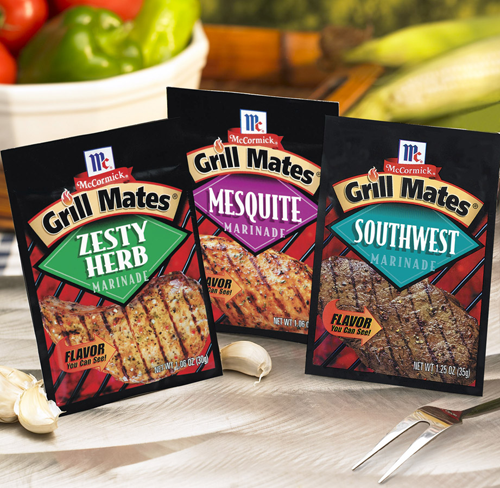 Grill Mates Seasoning Packets
——————————-
References:
——————————-
1 Smith JS, Ameri F, Gadgil P. Effect of marinades on the formation of heterocyclic amines in grilled beef steaks. Journal of Food Science. Published online ahead of print, July 2008. The study was supported by the Cooperative State Research, Education, and Extension Service, USDA and by the Kansas Agricultural Experiment Station Contribution from the Kansas Agricultural Experiment Station. To view the study abstract visit: http://www3.interscience.wiley.com/journal/120775665/abstract?CRETRY=1&SRETRY=0
2 Oxygen Radical Absorbance Capacity (ORAC) of Selected Foods – 2007, Nutrient Data Laboratory USDA, November 2007, www.ars.usda.gov/nutrientdata/ORAC.
Posted in McCormick & Co | No Comments »
February 4th, 2009
NEW! McCormick® Crusting Blends add a healthy crunch to your meals without deep frying.
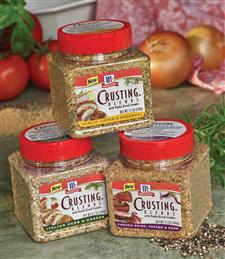 McCormick Panko Bread Crusting Blends Panko Bread Crumbs Bring Restaurant-Style Technique to the Table in Minutes
McCormick’s New Crusting Blends are a delicious, healthy and creative way to liven up mealtimes with restaurant-inspired flavorful crusts that add mouthwatering taste and texture to chicken, fish or pork.
All varieties of McCormick’s Crusting Blends use panko breadcrumbs, an on-trend take on traditional breadcrumb coatings. These Japanese-style crumbs are combined with specially-formulated herb and spice blends to create a delectable, distinctive flavor with a light, crispy crunch.
Varieties:
Posted in McCormick & Co | No Comments »
October 10th, 2008
NEW! McCormick® Grill Mates® Salmon Seasoning
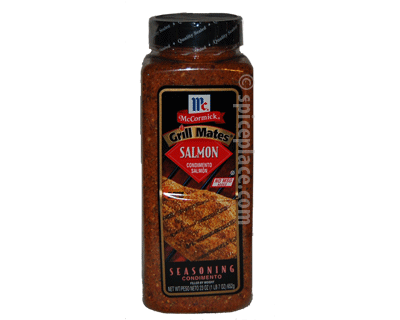 McCormick Grill Mates Salmon Seasoning The Perfect Complement to Grilled Salmon!
Across the country, Americans are looking for ways to eat more fish and seafood. Salmon, known for its distinctive flavor and ease of preparation, is a favorite main dish, especially in the warmer months as grilling season moves into high gear.
Now, barbecue grillers can enjoy perfectly seasoned salmon every time, with McCormick Grill Mates Salmon Seasoning. This new addition to the popular line of Grill Mates shake-on seasonings is an aromatic and delicious blend of spices and herbs, combined with a natural cedar smoke flavor.
Varieties of Grill Mates Seasonings: Grill Mates Salmon Seasoning joins the line of popular shake-on seasonings, including: Grill Mates Montreal Steak Seasoning, Spicy Montreal Steak, Montreal Chicken, Mesquite, Grill Mates Hamburger, Barbecue, Lemon Pepper with Herbs, and Garlic and Onion Medley.
How To: Simply shake on one teaspoon of Grill Mates Salmon Seasoning for every pound of seafood or fish, before grilling or baking.
Posted in McCormick & Co | No Comments »
May 22nd, 2008
 McCormick Spices for Health Seven “Super Spices”, Rich in Antioxidants, Deliver Big on Both Flavor and Function
HUNT VALLEY, MD – When you hear the word “antioxidants” mentioned, what foods immediately come to mind? Blueberries? Pomegranates? How about cinnamon?
That’s right, when it comes to antioxidant prowess, just one teaspoon of cinnamon vies for top billing along with a half cup of blueberries and one cup of pomegranate juice. Surprising to some, spices and herbs are extremely rich in antioxidants – with levels comparable to many fruits and vegetables, including today’s popular “super foods.”1
Nutritionists have long recommended spices and herbs as a way to add flavor without fat, salt or sugar – making it easier to meet today’s dietary guidelines. But now studies suggest adding more spices and herbs to your diet may not only please your palate, it could enhance your health.
“It’s the ultimate in good nutrition news when adding a favorite ingredient increases the health benefits of the foods we’re already enjoying,” said nutrition expert Wendy Bazilian, DrPH, RD, author of the newest edition of The SuperFoodsRx™ series, The SuperFoodsRx Diet: Lose Weight with the Power of SuperNutrients. “Using more spices and herbs is an easy, simple step that everyone can take to help improve the overall quality of their diet.”
To make it easy – and delicious – to enjoy the potential benefits of spices, McCormick® has created a unique collection of new recipes, specially designed to deliver up to half a teaspoon of antioxidant-rich spices per serving.
The Original Functional Foods?
In many cultures throughout history, spices and herbs have been used for both culinary and medicinal purposes. Only recently have scientists turned their attention to the potential health benefits of spices and herbs. “The study of spices is a relatively new area of nutrition science investigation, but one that holds great promise. What is especially encouraging is that the spice amounts being studied are reasonable for culinary usage,” said Dr. Bazilian.
Researchers are investigating the unique protective properties of spices and herbs, and their role in possibly reducing inflammation. Inflammation has been identified as a precursor to many chronic diseases. Other researchers are exploring the potential of spices to boost metabolism, promote satiety, aid weight management and enhance the overall quality of the diet. To advance the science of spices and herbs, McCormick created the McCormick Science Institute, an independent research organization supported by McCormick & Company, Inc.
Many spices and herbs appear to have some beneficial effects, but seven Super Spices that may hold the greatest potential to improve our health include:
More Reasons to Season
Botanically, spices and herbs are classified as fruits and vegetables. That’s why these plant-derived ingredients are naturally high in antioxidants. And, since they no longer contain the water that makes up a significant part of the weight of fresh produce, spices and herbs offer a big antioxidant punch in a very compact package. Spices and herbs also are rich in phytonutrients, such as carotenoids, flavonoids and other phenolics, which possess health-promoting properties beyond antioxidation.
To help enjoy the taste and health benefits of the Super Spices throughout the course of the day, Dr. Bazilian recommends these simple tips:
- At breakfast, sprinkle cinnamon on your bowl of oatmeal, yogurt, French toast or muffin batter. A dash of thyme is a welcome addition to scrambled eggs or omelets.
- At lunch, stir dried oregano leaves or red peppers into favorite canned soups, chicken/tuna salads or vinaigrette dressings. Even frozen pizza can get a delicious antioxidant boost. A sprinkling of ground ginger over sliced fresh fruit makes a refreshing dessert.
- At dinner, wake up the flavors of favorite side dishes with crushed rosemary leaves (a natural with mashed or roasted potatoes) or curry powder (perfect for rice dishes or couscous.)
SpicesforHealth.com
You’ll find everything you need to start enjoying the health and taste benefits of spices at www.spicesforhealth.com – a valuable resource to help you boost your intake of the seven Super Spices. Log on to find scores of new specially designed recipes that deliver a big hit of antioxidant-rich spices and other nutrient-packed ingredients. From appetizers, main dishes, sides and desserts – you’ll find an array of tempting recipes that are bursting with flavor and health-promoting potential. To jump start your use of more spices and herbs, you’ll find easy tips to add more flavor throughout the day. It’s as simple as perking up your morning coffee with ground cinnamon or lightly dusting hot popcorn with curry powder. Dr. Bazilian also offers her advice for adding more flavor to your day.
1Oxygen Radical Absorbance Capacity (ORAC) of Selected Foods – 2007, Nutrient Data Laboratory USDA, November 2007, www.ars.usda.gov/nutrientdata/ORAC.
Posted in McCormick & Co | No Comments »
December 20th, 2007
HUNT VALLEY, Md. (December 20, 2007) – The fragrant, visually stunning duo of poppy seed and rose captures America’s quest for the ultimate sensory experience. This combination is just one of McCormick’s top 10 flavor pairings featured in the just-released McCormick® Flavor Forecast™ 2008.
As the largest spice company in the world, McCormick keeps a finger on the pulse of flavor through an extensive network of researchers, trend experts, chefs, food technologists and sensory analysts. Together with leading restaurant chefs, cookbook authors and TV food personalities, they have identified the top tastes shaping how Americans will eat in the coming year.
“Our team of chefs is constantly exploring new ways to experience flavor – it is the heart of what we do,” said Kevan Vetter, Executive Chef at McCormick. “When we see a new spirit of adventure with ingredients like lemon grass and lychee or red curry and masa, we know it’s an exciting time for food and flavor.”
So what’s influencing the flavors of 2008? America’s escalating interest in health and wellness, the boundless passion for discovering authentic ingredients and cooking techniques from around the globe and the increased desire for local and artisan food are all driving forces in evolving our collective palate. McCormick explored these and other trends to develop the top 10 flavor pairings for 2008.
McCormick’s Top 10 flavor pairings:
- Oregano and Heirloom Beans: The intersection of functional food and fantastic flavor, this coupling is an antioxidant powerhouse.
- Vanilla Bean and Cardamom: A flavor match made in heaven taps into America’s growing passion for indulgent, yet approachable luxury.
- Chile and Cocoa: Old world authenticity in a modern context – the result is complex heat, depth, dimension and richness.
- Coriander and Coconut Water: The essence of the tropics coaxes nuances of a chameleon-like spice bringing forth light, clean flavors.
- Lemon Grass and Lychee: Exotic fruits from far away and the ever-growing popularity of Asian cuisines pave the way for this refreshing match.
- Red Curry and Masa: This duo brings together Latin and Asian influences to create a unique flavor experience.
- Orange Peel and Natural Wood: A new taste sensation is born when the smokiness of wood is matched with tangy orange peel.
- Allspice and Exotic Meats: This adventurous combination represents America’s pursuit of experimentation.
- Poppy Seed and Rose: An elegant and sensuous pair that captures the pursuit of cuisines from North Africa and the Middle East.
- Rubbed Sage and Rye Whiskey: A powerful, all-American team – sage is a wonderful complement to the dry, gutsy nature of rye whiskey, a historic beverage poised for a great renaissance.
Recipe: Rye on Rye Roast Beef Panini
- 1 can (14 1/2 ounces) low sodium beef broth
- 1/3 cup rye whiskey
- 1 1/2 teaspoons McCormick Rubbed Sage, divided
- 1/2 cup canola mayonnaise
- 2 tablespoons prepared horseradish
- 8 slices hearty rye bread with seeds (1/2-inch thick)
- 1 pound thinly sliced deli roast beef
- 1/2 cup jarred roasted red bell peppers, drained and sliced
- 2 cups arugula or chopped romain lettuce leaves
- Preheat electric panini maker according to manufacturer’s directions.
- Meanwhile, mix beef broth, rye whiskey and 1 teaspoon of the sage in medium saucepan. Bring to simmer on medium heat. Set aside, keeping au jus warm while preparing sandwiches.
- Mix mayonnaise, horseradish and remaining 1/2 teaspoon sage in small bowl.
- Lightly brush 1 side of each slice of bread with olive oil. Place bread, oiled side down, on a clean work surface. Spread top of each slice with 1 tablespoon of sage mayonnaise.
- Top 4 bread slices with roast beef, red bell peppers and arugula. Top each with second slice of bread, oiled side up.
- Place 2 sandwiches at a time on preheated panini maker. Cook 3 to 5 minutes or until bread is crisp and dark golden brown.
- Cut each sandwich in half.
- Serve with au jus in a large cup or small bowl for dipping.
Makes 4 servings of Rye on Rye Roast Beef Panini.
McCormick is a registered trademark of McCormick and Company, Hunt Valley, MD USA
Posted in McCormick & Co | No Comments »
November 3rd, 2007
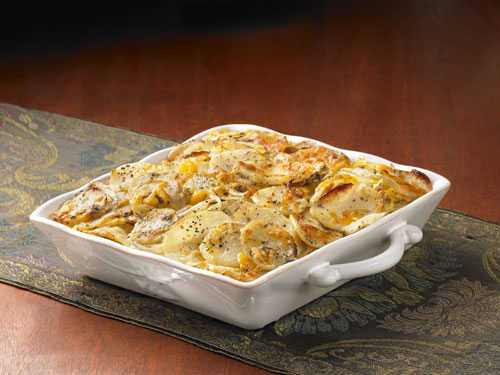
|
|
Sage Cheddar Cheese Potato Casserole
|
HUNT VALLEY, MD – With the holidays just around the corner, home cooks should be sure to have eight essential spices on-hand, according to an analysis of holiday favorite recipes by McCormick, the world’s leading spice company.
The McCormick Kitchens found these eight essential spices are key to more than 180 holiday recipes that will be prepared in kitchens across America between Thanksgiving Day and New Year’s Day.
- Allspice
- Cinnamon
- Clove
- Ginger
- Nutmeg
- Sage
- Pure Vanilla Extract
- Poultry seasoning
“We looked at traditional favorites for the holidays and found that these eight ingredients really are the building blocks for all your meal occasions,” said Laurie Harrsen, Director of Consumer Communications at McCormick. “It’s a good idea now – before the holiday crunch – to be sure your pantry is properly stocked, so you don’t come up short when you’re putting together your Thanksgiving turkey, pumpkin pie or sugar cookies.”
McCormick’s “menu math” reveals that cinnamon tops the list, showing up in more than 40 recipes, from sweet potatoes, to glazed ham to French toast. Nutmeg is another holiday hero, the key to a perfect eggnog or butternut squash soup. And, nothing says it’s the holidays more than homemade gingerbread, making ginger a must-have for the season.
Home cooks can enjoy entertaining this holiday season with delicious recipes featuring these essential eight spices. For a spectacular starter, try the Holiday Pomegranate and Orange Salad. It combines allspice and cinnamon with the sweet, tart flavor of pomegranate juice for a special vinaigrette. Savory Herb Rub Roasted Turkey features poultry seasoning and nutmeg with other spices to season the turkey inside and out. And, Overnight French Toast makes an easy and indulgent New Year’s Day brunch. These are just a few of the holiday recipes available at www.mccormick.com.
Posted in McCormick & Co | No Comments »
October 27th, 2007

|
|
Gingerbread Man Cookie
|
GINGERBREAD: A HOLIDAY CLASSIC
Gingerbread houses, gingerbread cookies, gingerbread cakes…there’s no better way to get in the holiday spirit than baking gingerbread for loved ones. Gingerbread is a tradition that brings family and friends together and kicks off the holiday baking season. To bring holiday bakers the very best, the McCormick Kitchens recommend this recipe for The Perfect Gingerbread Men. For more gingerbread recipes visit www.mccormick.com.
The Perfect Gingerbread Men
Preperation Time: 20 minutes
Refrigerate: 4 hours
Cooking Time: 10 minutes per batch
Ingredients:
- 3 cups flour
- 2 teaspoons McCormick® Ground Ginger
- 1 teaspoon McCormick® Ground Cinnamon
- 1 teaspoon baking soda
- 1/4 teaspoon McCormick® Ground Nutmeg
- 1/4 teaspoon salt
- 3/4 cup (1 1/2 sticks) butter, softened
- 3/4 cup firmly packed brown sugar
- 1/2 cup molasses
- 1 egg
Directions:
- Mix flour, ginger, cinnamon, baking soda, nutmeg and salt in large bowl. Beat butter and brown sugar in another large bowl with electric mixer on medium speed until light and fluffy. Add molasses and egg; beat well. Gradually beat in flour mixture on low speed until well mixed. Press dough to a thick flat disk; wrap in plastic wrap. Refrigerate 4 hours or overnight.
- Preheat oven to 350°F. Roll dough to 1/4-inch thickness on lightly floured work surface. Cut into gingerbread men shapes with 5-inch cookie cutter. Place 1 inch apart on ungreased baking sheets.
- Bake 8 to 10 minutes or until edges of cookies are set and just beginning to brown. Cool on baking sheets 1 to
2 minutes. Remove to wire racks to cool completely. Decorate cooled cookies as desired.
Recipe makes 2 dozen Gingerbread Cookies
Posted in McCormick & Co | No Comments »
October 13th, 2007

|
|
Eggnog Thumbprint Cookies
|
I can’t imagine a holiday celebration without a glass of eggnog, sprinkled with the spicy, sweet flavor of nutmeg. As chief spice buyer for McCormick, what fascinates me most about this simple holiday pleasure is where nutmeg comes from – both geographically and botanically. And, that takes me to Eastern Indonesia, where the vast majority of the world’s nutmeg is cultivated.
DESTINATION: Eastern Indonesia
Nutmeg Field Report
Nutmeg, the fruit of a tall, tropical tree, Myristica fragrens, is the source of not just one, but two aromatic spices – nutmeg and mace. Nutmeg is actually the seed from the fruit of the tree, which can grow to a height of 50 feet and live up to 75 years. Although the nutmeg producing tree bears some fruit year round, the main harvests are concentrated around March/April and October/November.
The annual world production of nutmeg is approximately 13 million pounds, relatively small when compared to the other holiday favorite – cinnamon. Indonesia grows about 75% of the world’s nutmeg, while Grenada is another major producer. Unfortunately, extensive tree damage from Hurricane Ivan in 2004 dramatically reduced the amount of nutmegs Grenada has been able to cultivate in recent years.
Native to the famous Molucca Islands, located in Eastern Indonesia, the first nutmeg trees grew on the eastern islands of Ternate and Ambon. Today, the majority of nutmeg trees are farmed in a series of small islands just north of Sulawesi, with one of the major islands being Siau. All the islands still border the Molucca Sea, and are located within 5 degrees north and south of the equator. Many have beautiful terrain, with lush green volcanic mountain ranges. Nutmegs grow best in elevations of 1,000 to 2,000 feet, and thrive very well in the nutrient-rich volcanic soil. The island of Siau has a large volcano which has been very active recently, making a visit there interesting to say the least! The only way to get to this island is by an all night ferry, in a pretty rough sea setting. Imagine arriving on this island exhausted, somewhat sea sick, only to be greeted by a very active volcano. Now this makes spice buying an adventure!
As I approach one of the many groves on Siau, I see tree branches full of yellow fruit, similar in size to nectarines. The outer portion of the fruit – the largest part – is fleshy and has the consistency of an unripe nectarine. It actually tastes like nutmeg! This part of the fruit is often used for making preserves and syrup.
When the fruit fully ripens on the tree, it naturally splits open, then falls to the ground where it is collected by the farmers. Breaking open the fruit reveals a lacy, scarlet red membrane that envelops a dark brown, brittle shell. The membrane is called the aril, which turns a dull red-orange when sun-dried by the harvesters. The dried aril is mace, which has a similar taste and aroma to nutmeg, but is slightly more delicate. After the mace is removed, what remains is the hard outer shell covering the nutmeg.
The nutmeg is extremely aromatic and has one of the highest amounts of volatile oil of all the spices. After sun-drying to develop its distinctive flavor, the outer shell is removed. Nutmegs are then sorted by size and visual appearance. The largest and most intact nutmegs are sold whole, and can be found in your local grocery store ready to be freshly grated. If you have a recipe that calls for mace, in a pinch, you can use nutmeg instead.
Nutmeg is one of the most popular holiday spices, and a part of nearly every cuisine. I enjoy nutmeg as a delicious flavor accent in vegetables, cookies, beverages and desserts.
Until our next adventure, happy holidays and best wishes for the New Year,
Al
Al Goetze is chief spice buyer for McCormick and Company, Hunt Valley, Maryland.
Posted in McCormick & Co | No Comments »
September 16th, 2007
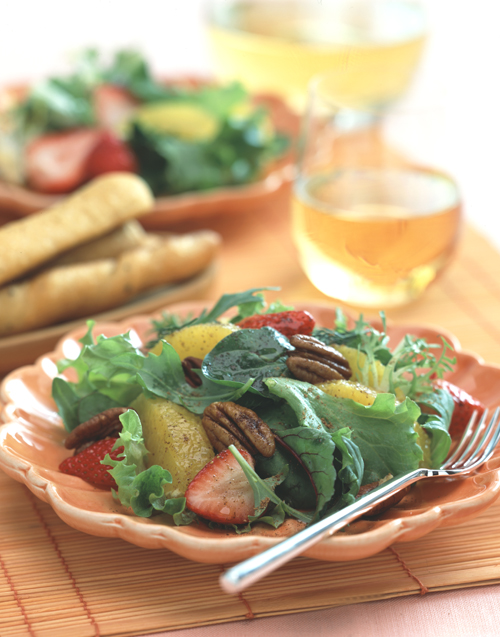
|
|
Field Greens Salad with Oranges, Strawberries and Chai Vinaigrette
|
DESTINATION: INDONESIA
Clove Field Report
McCormick’s chief spice buyer, Al Goetze, travels to exotic ports-of-call, trekking across varied terrain in search of the finest herbs and spices. In this journal entry, Al invites us inside his recent trip to Indonesia, where he inspected the clove crop.
One of the things I find so fascinating about spices is the fact that they come from all parts of the plant or tree – roots, bark, leaves, fruit, flowers, and seeds. Cloves (Syzgium aromaticum) are the immature flower buds of a tropical tree in the evergreen family that is grown in Indonesia, Madagascar, Zanzibar, India, Brazil, and other countries. My focus this trip is Indonesia, the largest grower and consumer of cloves.
In ancient history, the trading world sought access to a cluster of islands in the Molucca Sea, which were renowned for their spices – in particular, cloves and nutmeg. Though war and political unrest controlled this region for hundreds of years, today the islands are part of Indonesia. My port-of-call was a town called Larompong, located on the southern half of Sulawesi Island, in the heart of a major clove growing area.
Buyung, my local business associate, met me at the port and escorted me to observe the clove harvest. We drove for several hours through the lush, green countryside. Magnificent volcanic
mountains provided a picturesque backdrop for our trek.
During the drive, Buyung briefed me on last year’s prosperous crop and this surprising tidbit: the Indonesian clove cigarette industry is the single largest user of cloves in the world, accounting for about 90 percent of all production.
Arriving in the first farming village, we noticed clove trees interspersed throughout the hillsides and property borders. Similar to allspice trees, most parts of the clove tree exude some degree of aroma and flavor, though the flower buds are most potent. Clove trees can live 100 years and reach heights of 75 – 90 feet. Many of the larger trees have permanent bamboo scaffolding built around them to facilitate access to the flower buds.
Cloves are an annual crop, and similar to cinnamon, its farmers view it as a long-term investment. The farmer cultivates, and carefully monitors, the crop from the sapling stage. It takes years for farmers to realize the fruits of their labor. Typically, saplings don’t even generate flowers for the first five years of their life cycle. Once a tree has reached maturity, following the monsoon season, flower buds rapidly develop in size and color. They change from green to pale yellow to pink, and from there, quickly turn red, indicating full maturity. It is critical to harvest the buds just prior to this bright red stage, when they are at peak flavor and aroma. The harvest usually lasts two to three months.
When the buds are ready to be picked, farmers manually break them off, along with the stems and leaves. They then separate the buds, by hand, from the stems and spread them in yards to sun dry for about a week. This is how the cloves achieve the characteristic dark brown color we’ve all come to recognize. Dried cloves are handled very gently to help prevent the round bud head from breaking off from the base. At McCormick, all dried cloves are manually inspected, one at a time, to insure the highest quality.
The flavor of cloves is strong, pungent and sweet – almost hot. Because of their perceived medicinal properties, they have been used throughout history as a breath freshener and also to provide relief from toothaches.
During the spring months, one of the best ways to enjoy the flavor of cloves is in a traditional glazed ham. Clove is also seeing a resurgence in popularity as a key ingredient in one of the trendiest flavors of the moment – chai. I’ve recently discovered a simple chai vinagrette that is a delicious accompaniment to salads and a unique way to enjoy this fragrant spice.
The distinctive flavor of cloves combines with cardamom, cinnamon and white pepper in a chai vinaigrette — the perfect way to dress up this sensational salad, creating a palette as bright as
the season itself.
Recipes using Cloves
Field Greens with Oranges, Strawberries and Chai Vinaigrette
The distinctive flavor of cloves combines with cardamom, cinnamon and white pepper in a chai vinaigrette — the perfect way to dress up this sensational salad, creating a palette as bright as the season itself.
Ingredients
Vinaigrette:
- 1/3 cup olive oil
- 1/3 cup orange juice
- 1 tablespoon sugar
- 1 teaspoon Chai Spice Blend* (below)
- 1/8 teaspoon salt
Salad:
- 1 package (about 6 ounces) field greens or baby spinach
- 2 seedless oranges, peeled and sectioned
- 2 cups strawberry halves
- 1/2 cup pecan pieces, lightly toasted
Directions
- Mix Vinaigrette ingredients in small bowl until well blended.
- Mix all Salad ingredients in large bowl. Toss salad with vinaigrette just before serving.
Makes 6 (1-cup) servings.
Sweet and Spicy Glazed Ham
Cloves are the star of this traditional ham topped with a delicious golden glaze, made with honey and brown sugar.
Ingredients
- 1/2 cup firmly packed brown sugar
- 2 tablespoons honey
- 1 tablespoon water
- 1/2 teaspoon McCormick Ground Cloves
- 1 ready-to-eat ham (about 8 pounds)
- McCormick Whole Cloves
Directions
- Preheat oven to 350°F. Mix sugar, honey, water and ground cloves in small bowl. Place ham in large foil-lined roasting pan. Score top of ham in diamond pattern. Place whole cloves in centers and points of diamonds.
- Bake 1 1/2 hours, basting during last 1/2 hour with spice mixture. Let stand 15 minutes before slicing. Makes 18 servings.
No-Bake Chai Cheesecake
The combination of chai and chocolate takes this easy cheesecake to new heights.
Ingredients
- 1/2 cup hot fudge dessert topping
- 1 prepared chocolate crumb crust (6 ounces)
- 2 packages (8 ounces each) reduced fat (or Neufchâtel) cream cheese, softened
- 1/2 cup sugar
- 1 teaspoon Chai Spice Blend* (below)
- 1 tablespoon McCormick Pure Vanilla Extract
- 2 cups thawed frozen whipped topping
Directions
- Spoon fudge into crust, spreading evenly to cover bottom and sides of crust. Set aside.
- Beat cream cheese, sugar, Chai Spice Blend and vanilla in large bowl with electric mixer until well blended and smooth. Gently stir in whipped topping. Spoon into crust.
- Refrigerate 3 hours or until set. Heat additional dessert topping and drizzle over cheesecake before serving, if desired. Store leftover cheesecake in refrigerator.
Makes 8 servings.
* Chai Spice Blend:
Mix 2 teaspoons each:
- McCormick Ground Cardamom
- McCormick Saigon Cinnamon
- McCormick Ground Cloves
with 1 teaspoon McCormick Ground White Pepper until well blended.
McCormick® is a registered trademark of McCormick and Company, Hunt Valley, MD
Posted in McCormick & Co | No Comments »
September 10th, 2007
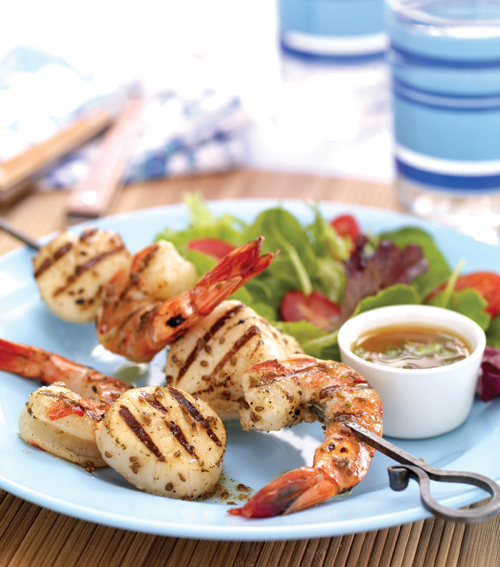
|
| Anise Seasoned Shrimp and Scallops
|
DESTINATION: TURKEY
ANISE Field Report
McCormick’s chief spice buyer, Al Goetze, travels to exotic ports-of-call, trekking across varied terrain in search of the finest herbs and spices. In this journal entry, Al invites us inside his recent trip to Turkey, where he inspected the anise crop.
Summer is the perfect time to enjoy anise seed. Its refreshing flavor is an ideal partner to the bold tastes of summer grilling. Though most associated with holiday baking, anise seed’s versatility has made it a popular ingredient year-round. I have just returned from Turkey where I took an early look at the forthcoming crop. Anise seed is indigenous to Eastern Mediterranean countries, including Greece, Turkey, Syria, and Egypt, and Turkey has one of the larger crops in the region.
My trip began at the Izmir Airport, where my business partner, Aysen, greeted me to embark on the 300-kilometer (200 mile) drive to the interior portion of Turkey. Most anise seed is cultivated in the southwestern towns of Denizli, Burdur, and Isparta. Like much of Turkey, this is beautiful country – a combination of farmland, lakes and mountainous terrain, with as many colors as an artist’s palette. Along the way, Aysen and I discussed this year’s crop projections. She told me that the harvest is expected to be healthy, which is great news because anise is definitely a flavor in demand.
After several hours of negotiating the narrow, winding roads, we finally entered the growing region. Cresting a hill, we came upon the farms, which are relatively small, and spread over flat parcels of land in and around the mountains. Like cumin, anise seed is a rotation crop, grown with barley, corn and wheat. The fields are sown in February and March, just prior to the arrival of the heavy rainy season. Nearing the time of the harvest, which is when I arrived, the weather turns sunny, very warm and dry.
The anise plant, Pimpinella anisum, or anason, as it’s known in Turkey, grows rapidly to a height of two to three feet and has beautiful, circular, feathery leaves and a canopy of small white flowers. If you close your eyes and picture the Queen Anne’s Lace that grows along the roadside in North America, you’ll have an idea of what a flowering anise plant looks like. The flowers are eventually replaced by seeds, which are crescent-shaped, strongly aromatic and full of licorice flavor and piney undertones, similar to fennel. The anise plant belongs to the same family of seed-producing plants as dill, caraway, coriander, cumin, and fennel.
Typically, the anise seed harvest begins in early June and continues into August. As we drove deeper into the growing areas, we came upon a field where harvest had begun earlier than expected. It was quite interesting to see the cut plants, hand-piled in the shape of teepees, sun drying in the fields. Once the drying is complete, farmers separate the seeds from the stalks using a basic threshing machine.
One of the most fascinating things, I find, about anise is the fact that farmers have been cultivating and harvesting the seed this way for centuries. Anise has been traced back to 1500 B.C. It was believed to aid digestion and was also a breath freshener, perhaps one reason for its prevalence in desserts and after-dinner drinks, such as Raki, the national beverage of Turkey.
After we finished inspecting the fields, Aysen and I stopped in a nearby village for dinner. There, we were treated to some wonderful lamb and fish dishes, and, of course, cookies – all made with local anise seeds. And, as is the custom, we toasted this year’s bountiful crop with Raki on the rocks.
Here are two of my favorite ways to enjoy anise in the summer – as a refreshing addition to grilled shrimp and scallops, and with fresh berries in a ricotta cream, a step up from the summer standby – strawberries and whipped cream.
I look forward to sharing my next journey with you this fall – a glimpse into my trip to Saigon to inspect the cinnamon crop. In the meantime, I wish you a flavorful summer!
McCormick® is a registered trademark of McCormick and Company, Hunt Valley, MD
Posted in McCormick & Co | No Comments »
|










